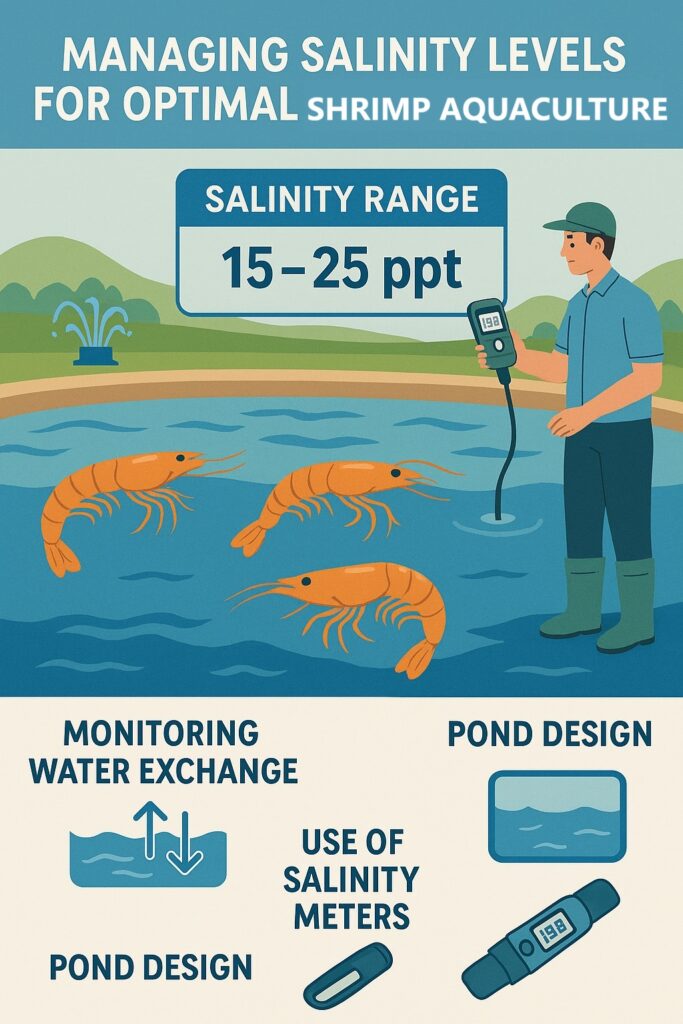Water salinity is one of the most critical factors in shrimp aquaculture, directly influencing shrimp survival, growth, and overall health. The optimal salinity range for most farmed shrimp is between 15–25 parts per thousand (ppt). Careful management of this parameter ensures stability, resilience, and long-term productivity.
As the global aquaculture industry expands, contributing significantly to both rural livelihoods and global seafood production, sustainable salinity management has become essential for shrimp farmers.
Effects of Salinity on Shrimp Growth in Shrimp Aquaculture
Salinity fluctuations can cause physiological stress in shrimp. Sudden changes—whether from rainfall, evaporation, or poor water management—disrupt osmoregulation, leading to:
- slower growth,
- reduced feeding activity, and
- greater susceptibility to disease.
Species differ in salinity tolerance:
- Pacific white shrimp (Litopenaeus vannamei) tolerates 0.5–40 ppt but thrives best at 15–25 ppt (FAO fact sheet).
- Black tiger shrimp (Penaeus monodon) prefers slightly higher salinity levels, around 15–30 ppt (World Aquaculture Society).
Keeping salinity within these preferred ranges enhances shrimp immunity, improves feed conversion ratios, and accelerates growth.
Techniques for Managing Salinity in Shrimp Aquaculture
1. Monitoring Water Exchange
Controlled water exchange in shrimp farming helps stabilize salinity while improving water quality. Farmers can balance freshwater and seawater inputs in coastal areas, while inland farms often rely on mineral supplements such as brine or sea salt.
Zero-water exchange systems and biofloc methods are also increasingly popular, reducing environmental impact while maintaining stable water parameters (MDPI study).
2. Pond Design and Construction
Well-designed shrimp ponds reduce sudden salinity fluctuations. Important features include:
- Adequate pond depth for buffering changes,
- Clay or plastic linings to prevent seepage,
- Aeration systems for mixing and uniform salinity distribution.
These designs ensure consistent conditions and prevent stress to shrimp stocks.
3. Use of Salinity Meters and Record-Keeping
Routine monitoring with refractometers and digital salinity meters ensures accuracy. During storms, droughts, or seasonal transitions, these tools allow farmers to act quickly to prevent harmful shifts.
Maintaining long-term records helps identify patterns, anticipate changes, and support better decision-making in integrated systems where shrimp may co-exist with tilapia, mollusks, or seaweed.
Conclusion: Basics of Shrimp Aquaculture
- Maintaining optimal salinity levels is fundamental to success in shrimp aquaculture. By stabilizing water conditions through water exchange management, pond design, and routine monitoring, farmers can:
- improve shrimp growth and survival,
- reduce disease risks,
- boost production efficiency, and
- build long-term sustainability.
Learn more about sustainable shrimp farming and ecolonomic practices at the EAT Community.

References & Further Reading
- FAO. Litopenaeus vannamei culture fact sheet.
- Boyd, C.E. (2018). Water Quality Management for Shrimp Farming. Auburn University.
- Funge-Smith, S., & Briggs, M. (1998). Nutrient budgets in intensive shrimp ponds. Aquaculture Research.
- JALA. The Key to Successful Water Exchange in Shrimp Farming.
- FAO Fisheries. Pond construction and design.
- Global Aquaculture Alliance. Water quality in shrimp ponds.
- Song, Z., Liu, C., Luan, Y., Qi, Y., & Xu, A. (2023). Effect of Zero Water Exchange Systems for Litopenaeus vannamei. Sustainability, 15(2).



